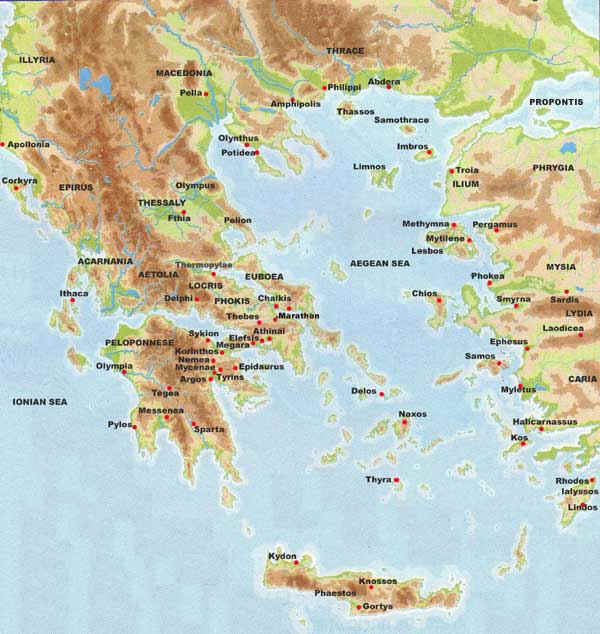
Chapter 4 The Persian and Greek World
Section 2 The City-States of Greece
While the Persians were laying the foundations for their vast empire,
further west another branch of the indo-European-speaking peoples
developed a very different style of civilization along the rocky coast
and islands of Greece and the Aegean Sea. In the eight century B.C. the
isolation of the Greek world began to break down. For historians of the
ancient Mediterranean civilizations, this century marks the end of the
"Dark Age" and the beginning of the "Archaic Age" in
Greek history (c. 750-478 B.C.). Greek civilization developed around
hundreds of independent city-states, which became the focal points for
Greek identity. Eventually,

Image from http://www.in2greece.com/english/maps/map_of_Ancient_Greece.jpg
The “Archaic Age” of Greece
As the isolation of the
so-called “Dark Age” began to end during the 700s, Greeks once again
looked out on a larger world. At the core of the emerging Greek
worldview was the conception of the polis, the primary
form of Greek political and social organization. Although today we
generally translate polis as “city-state,” for the Greeks it meant
much more than the English word can convey. The poleis (plural of
polis) had emerged during the violent and insecure days of the Dark Age
when many Greek tribes had banded together in small groups, each
centered on a hill or some other strong point that could provide
protection and be easily defended. As the Greeks struggled to survive,
they forged a whole new sense of identity around their poleis. For the
ancient Greeks the concept of the polis involved three interlocking
ideas: geographical territory; community; and political and economic
independence from any other group.
Independent city-states. Physically, the polis consisted of a city built around a defensible fortification called an acropolis, and the surrounding countryside from which the city drew most of its food. The average polis was relatively small, covering between 30 to 500 square miles. The relatively small size was important since ideally all citizens of the polis knew one another. Most poleis seem to have had less than a thousand adult male citizens, with perhaps ten times as many non-citizen inhabitants. Perhaps the most famous polis, Athens, was an exception. Athens covered over a thousand square miles, and had a commensurately larger population than most of the other poleis. In 431 B.C., for example, Athens had about forty thousand adult male citizens and a total population of some two hundred thousand people.
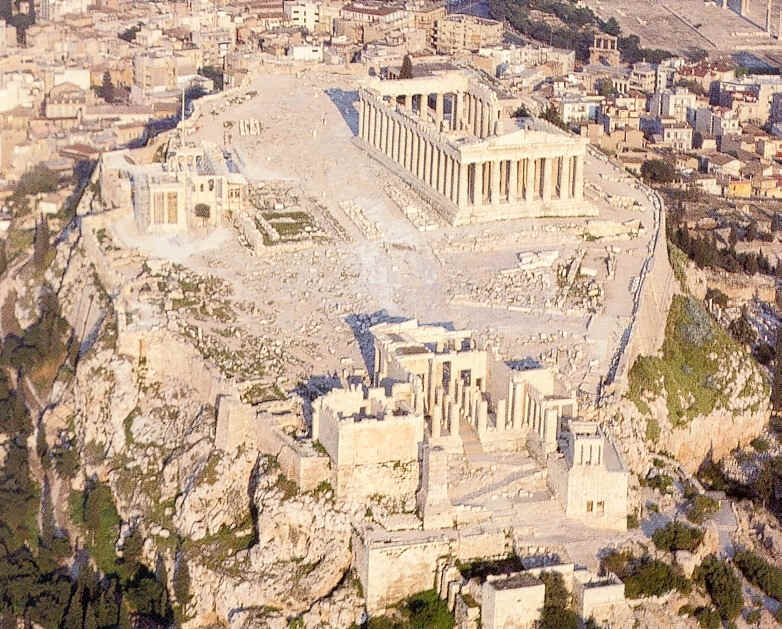
Ruins of the acropolis of Athens, from http://www.artlex.com/ArtLex/a/images/acropolis_aerial.lg.jpg
Whatever its size, however, the polis became the heart and soul of the Greek identity and fostered intense loyalty among its inhabitants. A later Greek philosopher, for example, went so far as to define the term “human being” as “an animal whose nature is to live in a polis.” An individual without a polis was indeed a lost soul for the ancient Greeks; the polis itself, on the other hand, was an absolutely independent and self-sufficient entity.
Perhaps the most important underlying principle of the polis was that a citizen was not an entirely autonomous individual, but rather belonged to the state. The Greeks made little or no distinction between public and private sectors of life. The polis had no professional bureaucracy, for example, nor a professional army, nor professional politicians – it relied on all of its citizens to fulfill all of these duties as required, in turn. Moreover, this concept of the polis allowed for no sense of individualism, as we know the term today.
All
Greeks were members of an interlocking set of larger and larger groups
– their family, clan, brotherhood, tribe and polis, in that order.
These groups provided both material and above all psychological security
for people in the face of a dangerous and insecure world – no one
stood alone. Consequently, in a polis any citizen could begin a legal
case in a matter of public concern. Even more, any citizen who avoided
participating in political life risked losing his citizenship
altogether. As one Athenian statesman put it:
"Here
each individual is interested not only in his own affairs but in the
affairs of the state as well: even those who are mostly occupied with
their own business are extremely well informed on general politics….
We do not say that a man who takes no interest in politics is a man who
minds his own business; we say that he has no business here at
all."
Life in the Polis
Within the walls of the polis, life centered on the agora, or market place. Here farmers from the surrounding countryside could sell their produce and buy in turn the goods made by artisans within the city or brought from beyond the polis by long-distance traders and merchants. Socially, three separate groups inhabited the polis – citizens, adult men with political rights and responsibilities; non-citizens, free people without political rights or responsibilities, such as women and children and resident foreigners; and slaves, who only counted as someone’s property.

Remains of the agora of Athens, looking across to the hill of the acropolis, from http://www.agathe.gr/image?id=Agora%3AImage%3A2008.18.0256;w=800;h=600
The Greek polis was an entirely male-dominated society. Women were supposed to stay in the home taking care of household responsibilities; men often saw them as a burden. According to one ancient text, even the poorest families always found means to keep sons, while even the richest families often exposed unwanted daughters on hillsides outside the cities to die. (Infanticide of unwanted children, either due to sex or physical deformity, was common among the Greeks as well as some other ancient peoples.) Part of the problem in this patriarchal Indo-European society, particularly when times were hard, was that daughters could be a serious economic liability – they had to be provided with a dowry either of goods or money before they could be married. As bad as their lot might be, however, if they survived childhood free women were still better off than the lowest group in Greek society – the slaves.
Although some of our earliest sources seem to suggest that
slavery was not always practiced among the Greeks, eventually slavery
became a fundamental institution in Greek society. Prisoners of war were
usually enslaved and even Greeks themselves could be sold (or sell
themselves or their children) into slavery in payment of debts. In some
cases, entire city populations were enslaved by conquerors. Slaves not
only worked in homes and in the fields, but in any other capacity their
masters might require. The worst life for a slave was in the mines,
where conditions were so harsh that few survived for very long. Although
customs varied from city to city, in general slaves had no rights
against their masters whatsoever.
Greek Colonization
The development of the poleis soon led to a falling Insecurity Index in Greece. By the 8th century B.C. mainland Greeks once again experienced rising levels of security and prosperity. The results were enormous – as people felt more secure, they began to have more children. At the same time, greater security and prosperity also made it possible for more children and young adults to actually survive into adulthood. Such prosperity, however, contained the seeds of its own destruction. The rapid and dramatic increase in population soon made it impossible for the cities to feed all their inhabitants. Under such pressures, the Insecurity Index once again began to rise. The solution to the problem for many poleis was colonization – some would have to leave in order to prevent the starvation of the entire population. Motivated primarily by land hunger, a wave of colonization began that would eventually disseminate Greek settlers and Greek culture all over the Mediterranean and the Black Sea.
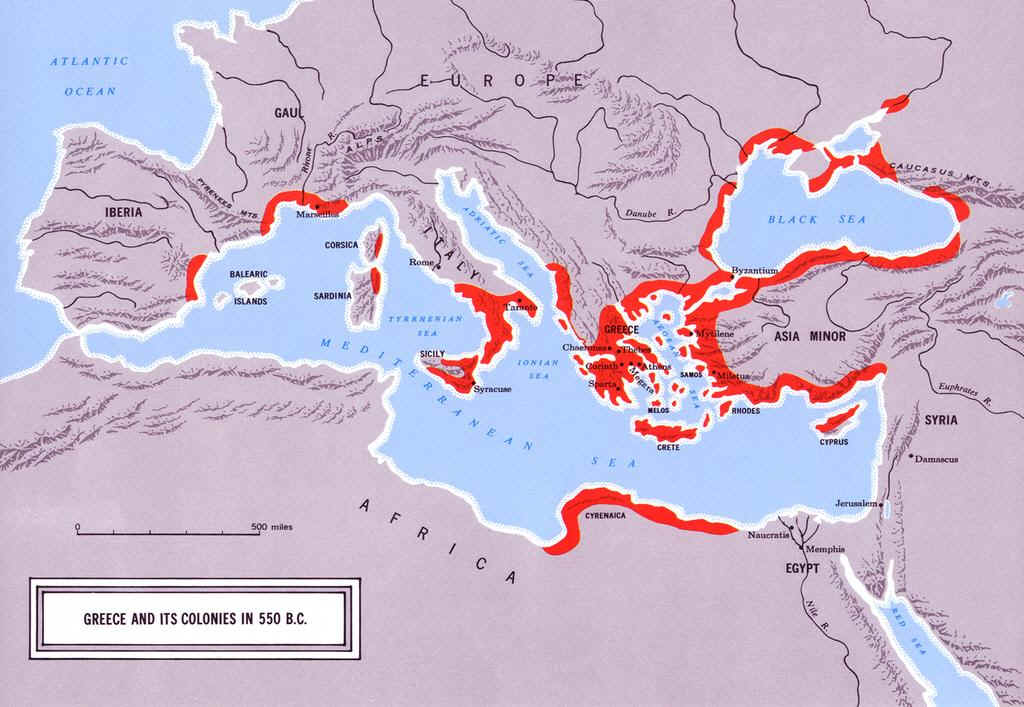
From http://www.utexas.edu/courses/greeksahoy!/greek_colonies_550.jpg
Land hunger may have been the primary impetus for Greek colonization but opportunities for trade and politics also played a role in decisions to go overseas. Greek colonists not only had to create their own political, social and economic systems in the new poleis they established, but they also came in contact with other cultures, which they soon realized were not necessarily inferior to their own. Although each of the new cities, like any Greek polis, was essentially independent of its mother city, most maintained cordial relations with them. In particular, most developed thriving export economies, whose chief trading partners were often the mother city. In the Black Sea region, for example, the colonies became producers and exporters of grain. In Sicily and southern Italy, they also produced olives and grapes, mostly for oil and wine.

Trade routes between Greek city-states and colonies, 750-550 B.C. from http://www.utexas.edu/courses/greeksahoy!/greek_trade.jpg
Cultural Revolution
The consequences of
Greek colonization were enormous. For three centuries, Greeks from the
mainland left their mother cities to establish themselves on the coast
of the Mediterranean Sea and the Black Sea "like frogs around a
pound" as one Greek philosopher would later put it. Colonists
emigrated south and west in the 8th century, north and east in the 7th
century, and in the 6th century they consolidated their
existing settlements. To the east and the south they confronted the more
advanced civilizations of the Near East and Egypt, from whom they
learned; in the north and the west (Scythia or Italy), they came into
contact with less advanced cultures, who learned from them. The result
was a melting pot, an original civilization that was nevertheless able
to incorporate ideas and influences from surrounding civilizations and
transmit them in modified form to others. Soon, many of these new ideas
began to filter back from the colonies to the mother cities in mainland
Greece – the result amounted to a cultural revolution in Greek
civilization.
Philosophy.
Perhaps the most important development of such new ideas in this period
began in the city of Miletus, on the western coast of Asia Minor - a
region known as Ionia. This Ionian Enlightenment, as it is
called, marked the beginning of an intellectual revolution and the birth
of western philosophy. It consisted of thinkers and teachers, who would
soon become known as philosophers, or “lovers of Wisdom,” who
devoted themselves to reflecting on the nature of the universe and the
place of man in that universe. For the first time, western man tried to
understand the world rather than to feel himself simply subject to it.
These first philosophers, who became known as the cosmologists, tried to
understand the essence of the universe, or kosmos as it was called in
Greek. Moderns may smile at their hypotheses but the importance remains
that for the first time human beings tried to understand first the world
and then man himself. The quest for philosophy had begun. From that
moment on the Greek mind would never stop asking questions about the
mysteries of life and the human condition.
Literature. One of the best indications of the changes occurring in Greek culture can be seen in the literature produced during the period. According to tradition, sometime around 750 B.C. the blind Greek poet, Homer, composed the Iliad, the story of the Trojan War. The great epic poem tells the tale of war between mainland Greeks, under the leadership of Bronze Age Mycenae, and the city of Troy on the Asian coast of the Aegean. Some 30 years later, around 720, Homer is also supposed to have composed a kind of sequel, the Odyssey, which traced the long voyage home of one of the Greek leaders, Odysseus of Ithaca, after the fall of Troy. A comparison of the two stories, however, gives a glimpse into the changes occurring in the Greek world even during Homer’s own lifetime.
The world of the Iliad is a closed world, even claustrophobic, centered entirely on the citadel of Troy. By the time of the Odyssey, on the other hand, the world has opened up. Odysseus sails freely over the whole Mediterranean. Motivations too have changed. The characters in the Iliad are guided by powers bigger than themselves, the gods, and do not really control their actions. Odysseus, "resourceful Odysseus" as Homer likes to call him, is an adventurer driven by his own curiosity who uses all his cunning to achieve his own goals. The picture of transformation during the 700s is completed by the works of Hesiod, who wrote at the very end of the century.
Hesiod was a pragmatic man writing for ordinary people about
their ordinary problems. In his poem, Works
and Days (700 B.C.?) he
advises his brother how to become a good farmer and a better man. This
is no heroic tale, but rather one of thoroughly human scale. Hesiod was
especially concerned about something that would become an essential and
permanent question in Greek thought—the nature of justice, and how to
live a right life in a just society. Thus, by the end of the 700s,
Greeks had begun to shake off their fairly limited view of life
illuminated only by tales of a heroic and aristocratic bronze-age
warrior society, and had instead begun to see the world from a
thoroughly practical and human point of view.
Political transformations. From a political point of view the Archaic Period witnessed the decline of monarchy and an essentially aristocratic order and the birth of democracy. The earliest city-states had begun as small kingdoms centered on hilltop fortresses. Their main purpose was defense and they were consequently ruled by those who provided that defense - warrior chieftains or kings, supported by a wealthy land-owning warrior elite. Land ownership for this ruling elite was critical, since land was the source of wealth and only those with wealth could afford the expensive bronze weapons and armor, chariots and horses on which successful Bronze Age warfare depended. By the 8th century, however, the wealthy landowning warriors had taken power into their own hands, overthrowing or limiting the powers of most of the kings and establishing aristocracies throughout Greece. These land-owning aristocrats, a term meaning "best men" in Greek, controlled every aspect of Greek society: they had a monopoly over the military (no commoner fought in the Iliad), control of the economy (they owned the land), of the judiciary (they were the judges in a system of customary law), religion (the gods would not listen to commoners), culture (Epic poetry is the literature of the aristocracy), society (they set the standards of social behavior), and of course, politics (they were the only ones to govern).
During the first half of the 7th century, however, the old aristocratic dominance began to diminish. To begin with, wealth was no longer entirely concentrated in the hands of a few aristocratic families: thanks to colonization, trading and commercial opportunities had made it possible for commoners to acquire wealth. Soon they too were able to buy land. Similarly, the aristocrats lost their military monopoly with the rise of the hoplites, heavily armed infantryman equipped with iron weapons and fighting in the phalanx formation - a large body of closely packed men, each holding a long iron-tipped spear pointed outward in a kind of porcupine-looking formation. A phalanx was a formidable military formation against which cavalry, before the invention of the stirrup, was powerless. The iron weapons and equipment of the hoplite, although expensive, could not be compared with the costs of bronze weapons or the financial burden of raising, training, and outfitting warhorses. At the same time, the phalanx formation required considerably more men than the small aristocratic class alone could provide. As wealthy commoners joined the ranks of the hoplites, and the phalanx replaced the chariot and the warhorse, commoners soon realized that they were even more important to the defense (and hence the survival) of their cities than the aristocrats.
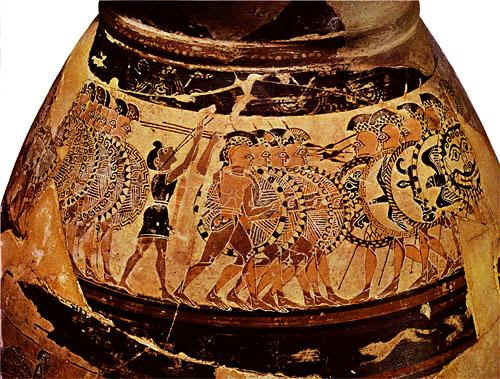
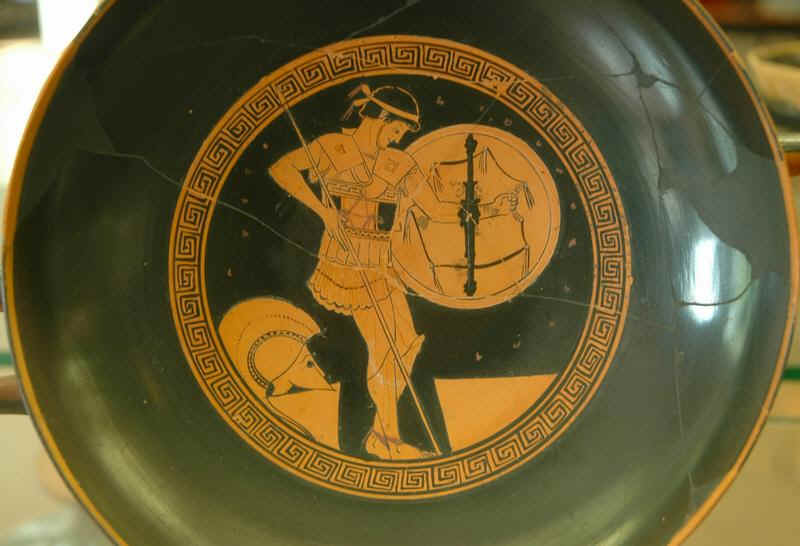
Painted images from Greek pottery depicting a single hoplite (below) and a group of hoplites in phalanx formation (above) from http://www.livius.org/pha-phd/phalanx/phalanx.html
As commoners became more and more important in the military defense of the polis, they also began to demand a fairer access to justice. In place of unwritten customary laws administered by aristocratic judges, the people began to demand that laws be written down so that all could see and understand them – and could expect judicial rulings to conform to them. This general movement toward legal codification in the second half of the 7th century effectively put an end to the arbitrary rule of the aristocracy. Culturally too, the patronage of wealthy commoners led to the development of new forms of art and literature – lyric poetry, for example, focused on personal feelings and emotions that were not limited to the aristocracy: all could associate themselves with feelings of love, friendship, or nature (as opposed to the heroic ideals of aristocratic warfare portrayed in Homer). Sapho of Lesbos, Archilochus of Paros, Terpander, to name only a few, ushered in what became known as the "Lyric Age of Greece".
ATHENS IN THE ARCHAIC AGE
By the seventh century B.C., Athens had brought all the cities and villages of Attica under her dominion. A polis in control of a large territory, Athens had been able to integrate the demographic growth of the 8th century without resorting to colonization. She had been less disturbed by the new social and economic conditions that had shaken the rest of Greece. And yet, the attempt of Cylon to establish himself as a tyrant (ca. 632 B.C.) and the promulgation of a code of laws by Draco (ca. 621 B.C.) show that she was not immune from the general movement against aristocratic privileges and hegemony.
Although
Attica remained essentially an agricultural society and aristocratic
families well established in the countryside were able to keep a better
control over the population than in other smaller poleis,
the crisis that exploded at the end of the 600s came from the gap
in wealth between the aristocrats and the rest of the population. Poor
farmers were over-burdened with debt and sometimes reduced to slavery
when unable to repay their creditors. At the same time, since land
ownership was a pre-requisite for participation in the army, the
consolidation of land ownership in fewer and fewer hands meant also a
reduction in the size of the citizen army. The combination of growing
internal social unrest and vulnerability to external attack became so
dangerous that the aristocrats decided to elect one of their members to
be a mediator with absolute power to resolve the crisis. Their choice
fell on Solon, who was elected to the chief magistracy for the year 594
B.C.
Solon’s reforms. Using his emergency authority, Solon carried out a vast range of reforms. To begin with, he cancelled all existing debts and restored the freedom of those who had fallen into slavery. In economic matters he tried to make Athens less dependent on agriculture by a series of reforms designed to encourage trade, commerce and industry. In politics his reforms were far more dramatic - he changed the political order from aristocracy to timocracy, a form of government in which the tenure of political offices depends on property qualifications. He divided the whole citizenry into four classes according to their wealth. The two wealthiest classes were eligible for the highest magistracies; the third could be elected to minor offices; the last category, although debarred from being elected to any public offices were given the right to elect candidates and pass legislation in the assembly (ecclesia). In a stroke, the monopoly the nobility had held on the political power of the state was broken.

Bust titled 'Solon' (National Museum, Naples) c.638-558 BC, from http://en.wikipedia.org/wiki/Solon
Solon's
political reforms were astute. He had successfully opened the doors of
political power to the new class of rich commoners without precipitating
a complete revolution. Since aristocrats remained the wealthiest members
of Athenian society his reforms did not suddenly deprive them of power
and influence but only required that they share it. Similarly, he
refused to bow to popular demands for the confiscation and
redistribution of land, a measure he considered unjust and too
revolutionary. On the other hand, Solon had not solved all the problems
and had left many people, both rich and poor, unsatisfied. Athens grew economically in the
decades following his reforms but not without increasing social tensions.
The Pisistratid tyranny. In 546 these tensions once again reached such a fever pitch that an aristocrat named Pisistratus, by appealing for support from the merchants and commoners, was able to short-circuit the electoral process and to take power illegally, though with a majority of popular support – a form of government that the ancient Greeks called tyranny.
Under the rule of Pisistratus and his sons (546-510 B.C.) Athens would know a period of relative political stability and economic prosperity. The Pisistratids (as the dynasty is called) curbed the power of the aristocracy and favored their natural allies, the merchants and the common people. On the other end, they did not overturn Solon's reforms. They left the popular assembly to elect magistrates and pass legislation, but only to the extent that they elected the Pisistratids’ own candidates and passed laws to which the tyrants did not object. Ironically, perhaps, by allowing this kind of controlled constitutional activity, the Pisistratids were actually giving people a chance to learn the technicalities of popular decision-making. Moreover, by forcing equality of all under the rule of one, they increased the sense of community in Athens. All citizens, poor and rich, aristocrats and commoners, were equal under the tyrant.
The Pisistratids were also important because they centralized Attica around Athens. They wanted the population to feel more attached to the city than to the countryside where the aristocrats were still powerful. An important program of civic building and the creation and development of civic festivals gave the Athenians a sense of pride in their city.
In 514, Hipparchus, one of the sons of
Pisistratus, was murdered and his brother Hippias became afraid for his
own life. Hippias then truly acted like a tyrant in the modern sense of
the word. As he persecuted his supposed enemies, the
people of Athens began to realize the true potential nature of tyranny.
Eventually they revolted and in 510 they forced Hippias into exile.
Athens thus recovered her freedom. Since the tyranny had essentially
overthrown both the old aristocracy and even the notion of timocracy
that had developed under Solon, the way was now open for yet another
experiment in self-government – democracy.
Cleisthenes and
democracy. The man who carried
through the last important political reforms of the Archaic Age in
Athens by instituting democracy was Cleisthenes (508 B.C.). Cleisthenes
kept the four classes established by Solon, though he included movable
property in the computation of a citizen’s wealth. In addition,
however, Cleisthenes divided the Athenian population into ten new
tribes. These tribes were based on residency, but each included a mix of
people from the city, the interior and the coast. In this way
Cleisthenes hoped to destroy the regional power of the aristocracy once
and for all. He also created a new council of Five Hundred that was to
prepare all matters to be presented to the popular assembly: every month
(the Athenian year was divided into ten months), a different tribe was
in charge of this council, which was composed of 50 citizens chosen by
lot. The Athenians considered the lot more democratic than elections.
Nobody could serve in this council more than twice in his life, so that
as many people as possible would have a chance to serve. But all the
legislative and electoral power remained with the ecclesia. Thus
Athens became what modern scholars call a 'direct democracy'. The people were not represented by
elected delegates (as in modern democratic/republican systems), but participated
directly in all major decisions and public offices.
SPARTA IN THE ARCHAIC AGE
Not all Greek city-states followed the same evolution toward democracy as Athens. And ironically, although later Western civilization would hold Athenian democracy up as the ideal of classical Greek civilization and the foundation of the West's own rise to both civilization and ultimately to democratic systems of government, for most Greeks at the time, a very different model commanded greater respect - that of Sparta. We have little information concerning the vast majority of the Greek poleis, but like Athens Sparta is an exception: its political and social system is well known since it gained great reputation for its stability and order.
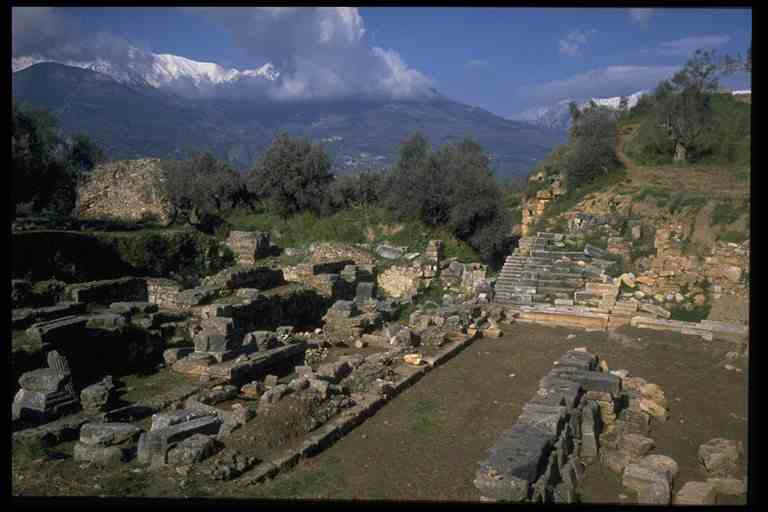
Ruins of the acropolis at Sparta, from http://www.fjkluth.com/sparta.html#Pict
Unlike Athens, Sparta is said to have received a constitution early in her history, a constitution associated with the legendary figure of Lycurgus. The later biographer Plutarch recorded that "everything concerning Lycurgus is subject to controversy" and his judgment still holds true. In its historical form, Sparta’s political order was composed of four institutions: [1] two kings (two different dynasties) had important religious and military powers. [2] They were assisted by a council of 28 citizens, 60 years old and older (the gerousia), a council that prepared business to be presented to the assembly of the citizens. [3] Five magistrates charged with the daily affairs of the state, and [4] the assembly of the citizens (Apella) which, at first, had the power to decide in last resort on every important matters. The members of the popular assembly were free male citizens 30 years old and older. They were known as the "equals" since, in Sparta there was no aristocratic order, nor economic inequality (each citizen received a farm from the state).
This system soon changed, however, and the people lost power to
the kings and the Gerousia through an amendment to the constitution that allowed the kings
and the council of elders to ignore any decisions made by the people if
they judged them unwise or inappropriate. At any rate, the Spartan state
was very stable and not until the fourth century did any opposition
appear to challenge the Lycurgan order. This political stability, as
well as the complete equality enjoyed by all Spartan citizens, made
Sparta the image of a well-ordered state worthy of praise and imitation
for most other Greeks.
A military state. Sparta was also renowned for her military might. Indeed Sparta was a military state, whose citizens were totally dedicated to war. In the eighth century, the Spartans took control of their neighbors in Laconia and Messenia. This made of Sparta the largest power in Greece and gave her economic independence. It also dictated the nature of Spartan society as well.
After the conquest Spartan society was divided into three
categories: the "equals," free citizens with political rights;
the so-called "half-citizens" (perioikoi), free population from
nearby communities dependent on Sparta, who paid taxes and might serve in the
army but had no political rights; and the helots, or state slaves, made up of
captives from wars and above all, the conquered Laconians and Messenians. While
the helots worked the farms given to each citizen by the state, the half-citizens concentrated on commercial and industrial activities.
Thus the equals were freed from any need to engage in economic activities to
support themselves - instead, they devoted all their time to military training. Such
military training was mandatory under the Spartan constitution and vital to the
state's survival because the helots outnumbered Spartan citizens by 7 to 1
- and were always ready to revolt. Consequently, the Spartans lived in
a permanent state of emergency, always ready to face uprisings from the
rest of the population. With such a constantly high Insecurity Index, Sparta
inevitably became a military state that kept the majority of its population
under control with a deliberate policy of brutality and terror. Indeed,
once a year the Spartans formally declared war on their helots, a practice that
gave equals the right to kill helots for any reason, without legal penalty.
Education and Spartan culture. The Spartan system of education was entirely focused on physical fitness and military training. At birth the child (male or female) was examined by a council of elders. If considered sickly the baby was exposed in the near by mountains until it died. Sparta could not afford unfit citizens.
From age seven to eighteen, boys trained intensively in what might be called early "boot-camps." From 18 to 20, they trained specifically for war. From age 20 to 30 all Spartan men were full time soldiers, living with their companions in barracks. Only after the age of 30 could a Spartan go home at night. Even then he remained in the military and until 60 had to take at least one meal every day with his fellow soldiers. He could get married at 20 but could not live with his wife and family before 30. As for women, they too underwent intensive physical training. Their primary role in Spartan society was to bear future soldiers and provide them with their early training.
As might be expected, the Spartan educational system made the best soldiers the world had known. On the other hand, military might was achieved at the expense of other activities. Spartans had virtually no interest in the arts, philosophy, or any other form of civilized culture. Only in sports, whose primary purpose was to provide conditioning and training for war, did Spartan athletes excel.